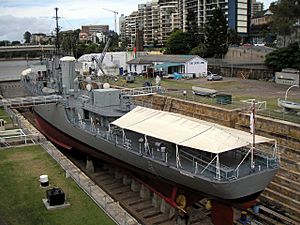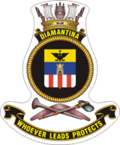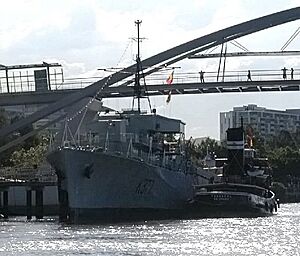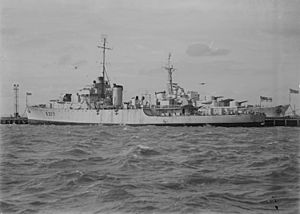HMAS Diamantina (K377) facts for kids

HMAS Diamantina in the South Brisbane Dry Dock in 2008
|
|
Quick facts for kids History |
|
|---|---|
| Name | Diamantina |
| Namesake | Diamantina River |
| Builder | Walkers Limited, Maryborough |
| Laid down | 12 April 1943 |
| Launched | 6 April 1944 |
| Commissioned | 27 April 1945 |
| Decommissioned | 9 August 1946 |
| Recommissioned | 22 June 1959 |
| Decommissioned | 21 February 1980 |
| Motto | "Whoever Leads Protects" |
| Honours and awards |
|
| Status | Preserved as a museum ship at Queensland Maritime Museum |
| Badge |  |
| General characteristics | |
| Class and type | River-class frigate |
| Displacement |
|
| Length |
|
| Beam | 36 ft 6 in (11.1 m) |
| Draught | 9 ft (2.7 m); 13 ft (4.0 m) (deep load) |
| Propulsion | 2 × Admiralty 3-drum boilers, 2 shafts, reciprocating vertical triple expansion, 5,500 ihp (4,100 kW) |
| Speed | 20 knots (37 km/h; 23 mph) |
| Range | 500 long tons (510 t; 560 short tons) oil fuel; 5,180 nautical miles (9,590 km; 5,960 mi) at 12 knots (22 km/h; 14 mph) |
| Complement | 140 |
| Armament |
|
HMAS Diamantina was a special ship in the Royal Australian Navy (RAN). It was named after the Diamantina River in Queensland. This ship, a type called a frigate, was built in the 1940s. It served in the navy from 1945 to 1946. Later, it became a survey ship from 1959 to 1980.
After its navy service, Diamantina became a museum ship at the Queensland Maritime Museum. It's a very special ship because it was the last frigate from World War II to serve in the Australian Navy. Out of 151 similar ships built around the world, Diamantina is one of only two that you can visit as a museum today.
Contents
Building a Warship: HMAS Diamantina's Design
Diamantina was a strong ship, weighing about 2,120 tons when fully loaded. It had two powerful engines that made it move through the water. The ship could travel a long distance, about 5,180 nautical miles, at a speed of 12 knots. Its top speed was 20 knots.
Weapons and Crew on Board
The ship was armed with two large 4-inch guns at the front and back. It also had smaller 20 mm Oerlikon guns. Later, these were changed to three 40 mm Bofors guns and four twin 20 mm Oerlikon guns. For finding submarines, it had a special "Hedgehog" projector and carried up to 50 depth charges. About 140 sailors worked on board.
When and Where Diamantina Was Built
The building of Diamantina started on April 12, 1943, at Walkers Limited in Maryborough. It was officially launched into the water on April 6, 1944. The ship joined the navy on April 27, 1945. Diamantina was one of eight River-class frigates built for the Australian Navy during World War II.
HMAS Diamantina's Time at Sea
Diamantina had two main periods of service in the navy. First, it helped during World War II. Later, it became a scientific research ship.
Serving in World War II (1945–1946)
After joining the navy, Diamantina went to New Guinea for its final tests. By June 1945, it was ready for action. The ship sailed to the Solomon Islands and helped Australian soldiers fighting in the Bougainville Campaign. It fired its guns to support troops on land in July and August 1945.
Important Surrenders at Sea
After the fighting ended, Diamantina played a key role in peace. On September 8, 1945, it carried Japanese officers to the surrender ceremony at Torokina. The ship also hosted the surrender ceremonies for Nauru on September 13 and Ocean Island on October 1. These important events happened right on its deck.
Diamantina returned to Sydney in December 1945. It then went on patrol in New Guinea waters in early 1946. In June, it came back to Sydney. On August 9, 1946, the ship was taken out of active service and put into reserve. For its service during the war, Diamantina received a special award called the "Pacific 1945" battle honour.
Exploring the Oceans (1959–1980)
Diamantina was brought back into service on June 22, 1959. This time, it was a research vessel. Its job was to study the ocean, weather, and water depths. It had different numbers during this time, like F377, A266, and GOR266.
Discovering the Deepest Point in the Indian Ocean
In July 1959, Diamantina completed its first ocean survey. It then began its first oceanographic cruise in August. In September, it surveyed the Montebello Islands after a British atomic test. In October, it surveyed the waters around Christmas Island.
One of Diamantina's most famous achievements happened on February 7, 1960. It discovered the deepest known part of the Indian Ocean. This deep spot was named Diamantina Deep after the ship. Based in Fremantle, Diamantina continued its ocean research until 1980. It briefly paused its duties in March 1963 to escort the royal yacht during Queen Elizabeth II's visit to Australia.
Becoming a Museum Ship
Diamantina officially left the Royal Australian Navy on February 29, 1980. It was the last frigate from World War II to serve Australia. The ship was then given to the Queensland Maritime Museum. It was moved to the South Brisbane Dry Dock on the Brisbane River in South Brisbane. There, it became a museum ship for people to visit.

In March 2006, Diamantina moved from its dock for the first time in 25 years. It was towed into the river so repairs could be made to the dry dock. On May 10, 2006, it returned to the South Brisbane Dry Dock. It has been a self-touring museum ship ever since. During the 2010–11 Queensland floods, the dry dock filled with water. However, the ship was well-maintained and floated safely with the floodwaters. Volunteers adjusted its ropes to keep it from hitting the dry dock. The ship was not damaged.



